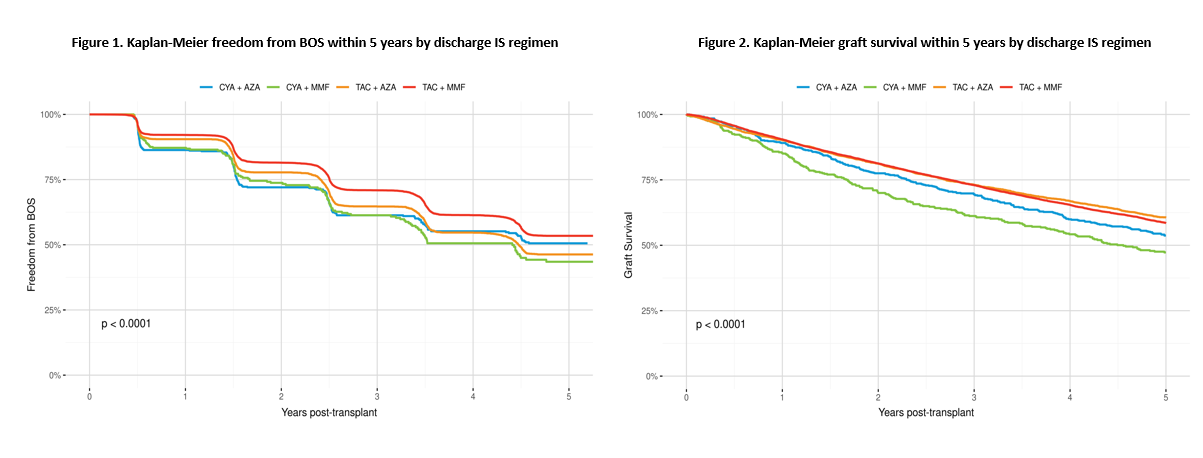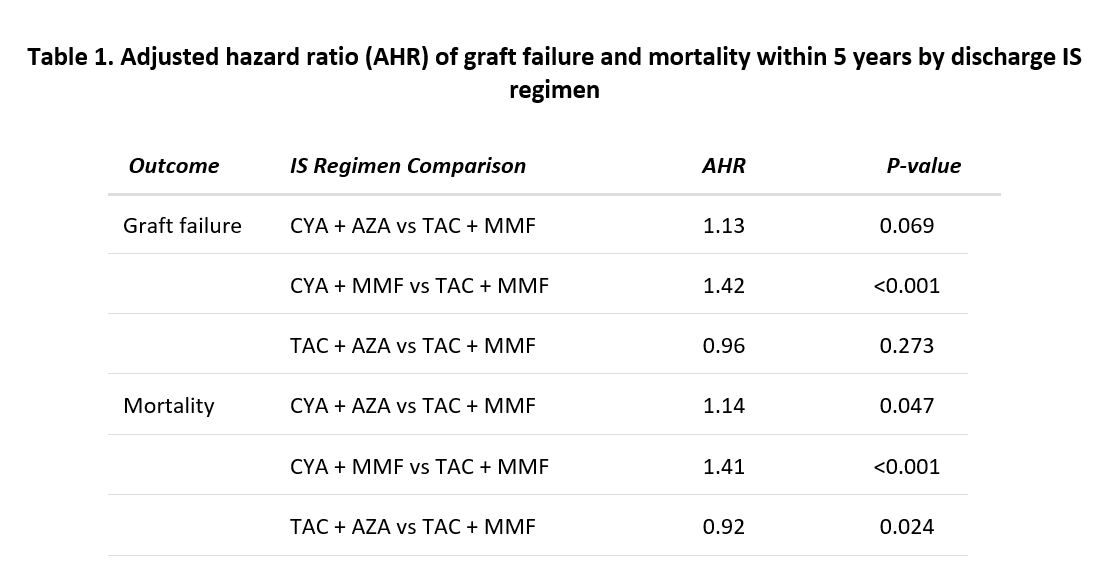Survival after Lung Transplantation by Discharge Immunosuppressive Regimen: An Analysis of Organ Procurement and Transplantation Network Data
1United Network for Organ Sharing, Richmond, VA, 2Duke University Hospital, Durham, NC, 3Fitzsimmons LLC, Vernon Hills, IL
Meeting: 2020 American Transplant Congress
Abstract number: 187
Keywords: Immunosuppression, Lung transplantation, Multivariate analysis, Outcome
Session Information
Session Name: Living in the Real World: Decision Making and Outcomes After Lung Transplant
Session Type: Oral Abstract Session
Date: Saturday, May 30, 2020
Session Time: 3:15pm-4:45pm
 Presentation Time: 3:27pm-3:39pm
Presentation Time: 3:27pm-3:39pm
Location: Virtual
*Purpose: As the optimal immunosuppressive (IS) regimen after lung (LU) transplant (TX) is unknown, we conducted an analysis to compare the effect of four different IS combinations on graft and patient survival for adult lung TX recipients in the US.
*Methods: Adult recipients of primary, deceased donor, LU alone TXs during 2005-2015 from the Organ Procurement and Transplantation Network (OPTN) data were included. Recipients who were alive at discharge were categorized into one of the following discharge IS regimens: cyclosporine + azathioprine (CYA+AZA), cyclosporine + mycophenolate mofetil (CYA+MMF), tacrolimus + azathioprine (TAC+AZA), or TAC+MMF. Survival within 5 years was estimated using Kaplan-Meier method and compared by IS regimen using a log-rank test. Cox regression models were used to assess the association of IS regimen with graft and patient survival, adjusted for other covariates. The results of the Cox models are presented as adjusted hazard ratio (AHR) and p-value.
*Results: Among 14,798 recipients in the cohort, 10,842 (73%) were on TAC+MMF, 2,968 (20%) on TAC+AZA, 587 (4%) on CYA+AZA, and 401 (3%) were on CYA+MMF. Unadjusted graft and patient survival were significantly different across IS regimens (Figures 1-2).
Table 1 shows that as compared to TAC+MMF, CYA+MMF was associated with a significantly increased risk of graft failure (AHR=1.42; p<0.001) and mortality (AHR=1.41; p<0.001), while CYA+AZA was associated with a marginally increased risk of graft failure (AHR=1.13; p=0.07) and mortality within 5 years (AHR=1.14; p=0.05). TAC+AZA was associated with a significantly lower risk of mortality within 5 years compared to TAC+MMF (AHR=0.92; p=0.02).
*Conclusions: The adjusted analysis of OPTN registry showed that CYA+MMF was associated with a significantly higher risk of graft failure and mortality within 5 years compared to TAC+MMF, while TAC+AZA was associated with a significantly lower risk of mortality compared TAC+MMF. It should be noted that the analysis included small numbers of patients in some of the IS groups and only accounted for IS regimen at discharge.
To cite this abstract in AMA style:
Cherikh WS, Plucinski BJ, Palmer S, Fitzsimmons WE. Survival after Lung Transplantation by Discharge Immunosuppressive Regimen: An Analysis of Organ Procurement and Transplantation Network Data [abstract]. Am J Transplant. 2020; 20 (suppl 3). https://atcmeetingabstracts.com/abstract/survival-after-lung-transplantation-by-discharge-immunosuppressive-regimen-an-analysis-of-organ-procurement-and-transplantation-network-data/. Accessed December 14, 2025.« Back to 2020 American Transplant Congress


